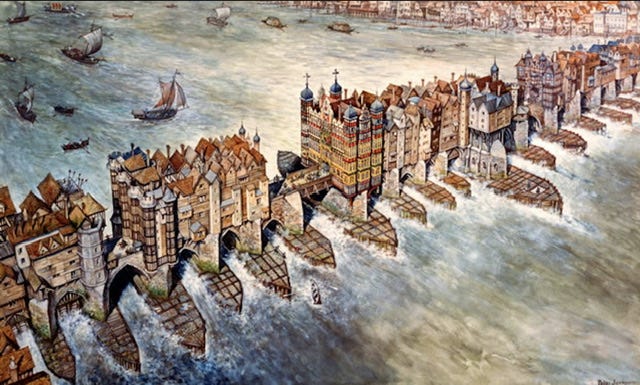How We Homeschooled Today #80
A library visit and a very hot walk around Medieval London
(If you’re new here, my son is 5 and my daughter is 7.)
Some quick work at home this morning before we headed into the City of London.
1 new spelling for my son, and revising 5 spellings for my daughter.
Revised 8 flashcards from Multiplication by Heart
Revised lots of Ancient Greek words and added one more. (For new readers, we are using Basil Batrakhos for Ancient Greek. It’s designed for 9-12 year olds so we are taking it very slowly. At the moment we are just learning the new vocab for Chapters 3 and 4 and I am wondering if it’s madness to try and teach a five year old about things like ‘first person singular’. But if I don’t teach them, how beneficial is a long list of Greek words with no idea how to string them together? On the plus side, they both know the Greek alphabet and already have a good bank of words in their heads, which is no mean feat at 5 and 7. We may possibly change tack and focus on root words. I’ll keep pondering. Thoughts and advice welcome!)
We went out before we’d managed French and maths (I’m trying to do a few Multiplication by Heart cards in addition to other maths, rather than instead of, now the children are pretty confident on their multiplication tables. But this is not always a popular suggestion!)
On the way to the library, both children read books from the Flat Stanley series. At the library, we borrowed the following: (Lots of these were my suggestions. We’ll see how popular they prove.)
At the Hospital, At the Vet, The Golden Touch—old favourite Biff Chip and Kipper reading books
More Flat Stanley stories
The Phantom Tollbooth, Norton Juster
The Way to Sattin Shore, Philippa Pearce
The Battle of the Viking Woman, Terry Deary
The Family from One End Street, Eve Garnett
Stig of the Dump, Clive King
The Smashing Saxons, Terry Deary
Joan of Arc, DK Readers
The Great Plague, Pam Robson
After the library I bribed the children with Smarties and took them on a short but very warm walking tour of medieval parts of the City. I used this map which you can pick up free in the City of London Tourist Information Centre opposite St Paul’s Cathedral. There are lots of different historic themes available. Before we got down the the River Thames we stopped in at St James Garlickhythe, designed by Sir Christopher Wren, which had a professional pianist inside playing something beautiful. I wish I knew what it was. It’s extraordinary how often we wander into a City church to find exceptional music being played, for free.
Then down to the river, where I told the children about the River Walbrook which used to run above ground and divided medieval London in half. I explained it was used for potteries and leather making so would have been busy and smelly, not a sparkling stream flowing between the city streets. We talked about how the Thames was a busy port, with boats unloading grain and firewood from further inland, and spices, furs, and silks from Europe. We walked under London Bridge and talked about how the old London Bridge used to be covered in buildings and had many more supporting piers. We have read descriptions of this in Monica Dickens’ excellent historical story The Great Fire, which describes boats ‘shooting the rapids’ to go from one side of the bridge to the other because the bridge choked up the river so much. I wanted to take them into St Magnus the Martyr to show them a model of the old bridge, but it was closed today. (My fault for not checking first, but we did get to see the large piece of timber from the Roman wharf which had stood nearby, which was pretty cool.)

They don’t make ‘em like they used to. Via @MrEwanMorrison. More Flat Stanley on the way home, then playing in the garden with a friend. At tea I read aloud from Medieval Town, which gave us more of an idea of what London would have been like in the Middle Ages. They were horrified to learn that almost half of babies born in medieval towns died before their fifth birthday.
Reading in bed: Greek Myths for Young Children, A Witch Got on at Paddington Station, Fortunately, The Milk by Neil Gaiman.
Thanks for reading. If you’re not a subscriber, sign up for free and never miss a post.




Would love to have discussions on different approaches to teaching Greek! We are not doing grammar now - mostly vocabulary - but Fridas teacher also tries to bring in a lot of songs, plays and short stories, which Frida loves! I find the songs really help the most. Her teacher was a famous composer, so she makes all the songs herself 😊
How lovely to be reading the Phantom Tollbooth for the first time! Love Stig of the Dump too!